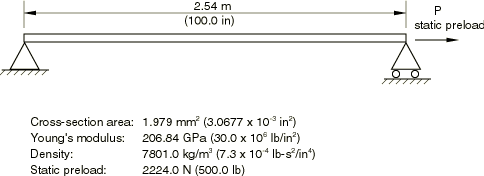Vibration of a cable under tension | ||
| ||
ProductsAbaqus/Standard
Problem description
The truss model is shown in Figure 1. The cable is modeled using 13 truss elements of type T2D2 (two-dimensional, 2-node, linear interpolation). A tensile force of 2224 N (500 lb) is first applied to the cable in a static step. In the first increment of this step the model has one singular degree of freedom at each node, because the unstressed cable has no stiffness associated with transverse displacement. As soon as the cable has some tension, it offers stiffness to transverse motion through the initial stress terms. Thus, the user must take care to constrain these singular degrees of freedom initially, and remove the constraints once the tensile stress has been created. Alternatively, very weak springs could be used. In fact, this example is set up so that these temporary constraints are not needed because the cable is aligned exactly parallel to one of the global axis directions. Thus, the stiffness will be initially identically zero in the other global axis direction. Abaqus will recognize this and automatically eliminate those degrees of freedom in the initial increment. In both steps of this analysis, the preload and the eigenvalue extraction, the initial stress effect is obtained by considering geometric nonlinearities.
The first four eigenvalues are requested. The data also specify that only frequencies up to 1000 Hz should be extracted. The eigenvalue extraction will, therefore, terminate when four frequencies have been calculated or when convergence has been achieved for one mode whose frequency is above 1000 Hz, whichever condition occurs first.
vibrationcable_b21.inp is a model using 13 B21 elements. The loading and the boundary conditions for this problem are the same as the truss model. Four eigenvalues are requested.
![]()
Results and discussion
Four distinct frequencies are obtained. The frequencies are given in Table 1, where they are compared to the exact solution, taken from Thomson (1965). As might be expected, the lowest frequency is predicted very accurately, with the error growing for the higher modes. A finer mesh would provide more accuracy in the higher modes. The beam model results are very close to the truss model results.
![]()
Input files
- vibrationcable_t2d2.inp
T2D2 elements.
- vibrationcable_b21.inp
B21 elements.
- vibrationcable_elmatrix.inp
Element matrices output in the beam example.
![]()
References
- Vibration Theory and Applications, Prentice-Hall, New Jersey, 1965.
![]()
Tables
| Mode | Exact | Abaqus | Error | Abaqus | Error |
|---|---|---|---|---|---|
| (Thomson, 1965) | T2D2 | T2D2 | B21 | B21 | |
| 1 | 74.7 | 74.3 | −0.5% | 74.3 | −0.5% |
| 2 | 149. | 148. | −1.2% | 148. | −1.2% |
| 3 | 224. | 219. | −2.4% | 219. | −2.4% |
| 4 | 299. | 287. | −4.1% | 287. | −4.1% |
![]()
Figures
